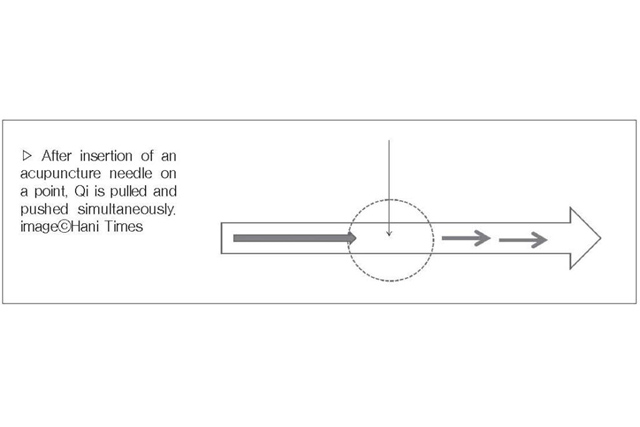By Brandon SJ Oh, Ph.D., L.Ac.
If a patient has symptoms on upper body, acupuncture treatment should be performed on corresponding lower body.

Every study has its own principle and reason. Applying, practicing, and understanding any study or theory should be achieved by careful consideration of the principle and reason.
So far, numerous scholars and researchers have done their best to prove and clarify effects of acupuncture treatment using modern scientific methods. Although there are studies to explain the benefits of acupuncture treatment, the results have yet to explain Eastern scientific thought by means of Western scientific language. Moreover, there is difficulty for researcher to explain uncertain and unseen matter, such as Qi, using the Western scientific method.
In order to avoid logical errors from clarifying the mechanisms of acupuncture, I focus on the mechanism of Qi to explain existing acupuncture techniques. My hypothesis starts from defining that Qi exists and can be controlled by acupuncture.
A Mechanism of Acupuncture: Qi tends to be pulled and pushed where an acupuncture needle is inserted.
To continue and explain my theory, I presume that there is Qi even if it is not seen and touched.
The 12 Meridians or channels are basically a linear concept. The meridians cover the human body vertically and horizontally and surface to inside of human body like a web. There also are meridian muscle (경근, 經筋) and meridian skins(피부, 12皮膚) that constitute the 12 meridians throughout the human body. In order to use a meridian for acupuncture treatment, it should be simplified and considered as linear.
First, we know that inserted acupuncture needles pull Qi toward where the needle is located. After an acupuncture needle penetrates skin, the area where the needle is inserted turns red. This explains how the site of the acupuncture needle insertion pulls blood and Qi. According to basic acupuncture theory, where Qi goes, blood follows. Simultaneously Qi is pushed away from the needle insertion location along with the meridian.
This explains how acupuncture needle to enhance Qi and Blood circulation on a meridian in order to reduce muscle pain and cure internal organ’s malfunction. According to Asian Medicine theory, pain caused by obstructed Qi and blood circulation due to various reasons. To treat and reduce pain, an acupuncturist should diagnose and clear causes of obstructions on meridians where the pain located.
Second, stronger stimulation of acupuncture takes place on the extremities. Acupuncture points on tips of fingers and toes (well points, 井穴) especially have the strongest Qi stimulation.
Various upper body symptoms could be taken care of by lower body treatment.
If a patient complains of frontal headache or stuffiness of stomach due to indigestion, the targeted acupuncture points should be at the feet on the Stomach meridian. This is based on the theory that upper body symptoms could be resolved by using acupuncture points located on the Stomach meridian in lower body parts.
This means that to treat headache due to indigestion, any acupuncture points on the Stomach meridian under the St.36(足三里) and ST41(解谿), ST42(衝陽), ST43(陷谷), ST44(內庭), ST45(厲兌) can bring down obstructed Qi down to resolve headaches.
I believe that when a practitioner recognizes the meridian that causes the symptom and start to acupuncture treatment, the symptom will be resolved even if there is different degree of treatment effects for each acupuncture points on the Stomach meridian.
Stimulation of Interior(裏)/Exterior(表)
According to Traditional Chinese Medicine (TCM), the interior (裏) meridians belongs to Yin(Zang) organs and the exterior (表) meridians belongs to Yang(Fu) organs.
TCM analyzes the physiological function of the body based on the harmonious relationships between yin and yang organs. Yin organs such as lungs, spleen, liver, heart, and kidneys, are thought to have more internal functions and are called interior organs. The yang organs, such as large intestine, stomach, gall bladder, and urinary bladder on the other hand, are believed to have more external functions and are considered exterior organs.
The Yang and Ying organs, there are pair relationships from which the interior and exterior relationship theory was developed. For example, lungs are Yin and its paired Yang organ is the large intestine, liver is Yin and its Yang organ is the gall bladder, kidneys are Yin and its Yang organ is the urinary bladder and so on.
When there is indigestion, Qi needs to be brought down from upper body and delivered to the meridian which has an Interior (裏)/Exterior(表) meridian relationship, the Spleen meridian. In order to guide Qi to abdomen, take any acupuncture points on the spleen meridian on the leg. Qi will be pushed toward the abdomen by the spleen meridian according to the Interior/Exterior relationship of the stomach and spleen. Once Qi is guided to the abdomen, the body purifies any abnormalities and symptoms are resolved.
In the case of headaches, especially with tension headaches (陽明頭痛) and weak body conditions, careful approaches need to be taken by means of acupuncture. Also weak body condition is considered as a lack of upper body Qi circulation in general. In order to prevent sudden loss of Qi circulation, which easily leads to dizziness and distribution on head it is recommended to use Li11. (Continuing next edition)

































